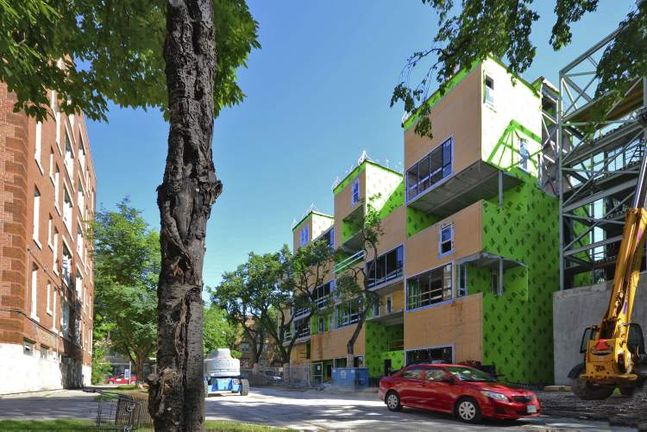Strategic thinking needed with Winnipeg seeing growth

Winnipeg's population is nearing 800,000 and is growing by more than 10,000 per year. Property values are rising, construction is happening and the economy is prospering. We have an IKEA, a professional hockey team and a half-dozen new towers rising in our skyline.
Winnipeg is without question a progressing city -- but is it a progressive one?
After decades of stagnation, Winnipeg is beginning to face the challenges that come with more rapid urban growth. The suburbs are sprawling in every direction, traffic levels are increasing and established neighbourhoods are being redeveloped. The city is evolving and we are at the point of having to ask ourselves: What kind of community do we want Winnipeg to become?
Old Winnipeg was a special place, filled with dense, tree-lined, walkable neighbourhoods of grid-pattern streets, community clubs and corner stores. Will new Winnipeg have the same character and soul, or will we look back on this growth period as a lost opportunity to progressively shape our future city? Will we have the same pride and foresight as those who planted our characteristic tree canopy a century ago, or will we leave a legacy of ubiquitous suburbs, unmanageable civic finances and crumbling infrastructure?
In 2011, city council voted to accept the Our Winnipeg plan and the Complete Communities Direction Strategy into official civic policy as a response to these very questions. These comprehensive planning guidelines are intended to provide a progressive blueprint for the city's economic, social and physical growth over the next 25 years. Our Winnipeg emphasizes creative ways to guide new neighbourhood design and transform existing areas into "complete communities." It focuses on developing mixed-use, mixed-income and mixed-density neighbourhoods that are walkable, safe, beautiful and vibrant. Perhaps, most importantly, it outlines ways to make the city more economically sustainable by curbing the prevailing model of low-density, expansive growth that has already stressed civic budgets to a point where taxes are rising and public services are declining.
Our Winnipeg is a long-term plan, but it is not a law. Without aligning its strategies with current zoning bylaws, the document becomes a fanciful vision without any real method of implementation.
Earlier this month, city council chose to defer their vote on a series of recommendations from the planning, property and development department that would align several features of Our Winnipeg with zoning bylaws. The recommendations focused on reducing red tape and streamlining the approval process for desirable development.
Densification of existing neighbourhoods is seen as a key strategy for making the city more economically sustainable in the long term, but the provision of parking to meet current bylaw standards can be a barrier to infill development on smaller urban sites. The recommendations addressed this issue by reducing minimum parking levels in mature communities, permitting some on-street parking for multi-family developments and allowing car-share and bike programs to offset parking requirements.
To promote the subdivision of larger properties, it was recommended that the minimum required lot areas be reduced while allowing properties to be subdivided as long as newly created lots are no smaller than existing ones located within 60 metres on the same street.
These modest changes met with apprehension from council, which cited fears of increased street parking and smaller residential properties that might be considered unappealing to community residents. It is human nature to fear change, but councillors who struggle every year to balance civic budgets likely understand our current urban-development model is not economically sustainable. As Winnipeg grows, promoting density is the only way to ensure a healthy and competitive city in the future. To prosper, we will have to embrace the long-term goals outlined in the Our Winnipeg plan by empowering it with a legal backbone.
This resistance to long-term planning as a method of guiding change seems to have recently become a trend in Winnipeg. Last year, the Corydon-Osborne Neighbourhood Plan was stopped in its tracks despite the pressing need to address significant changes happening in the area. Promises to restart the process have gone unfulfilled for almost a year.
Recently, the City of Winnipeg cancelled its active-transportation study, indicating its $400,000 cost would be better spent on construction. The complex web of bike and pedestrian paths, intertwined with transit and vehicular networks across the city, will now be implemented without a strategic plan to ensure its efficiency and cost-effectiveness. The argument appears to fall flat considering other studies continue, including a $1.2-million plan for the development of the Waverley Street underpass.
The lessons of proceeding without planning and public consultation might have been learned when a hotel and water park near The Forks were abruptly proposed, resulting in significant community opposition and the eventual failure of the project. The value of an effective urban plan can be seen as the Winnipeg Blue Bombers implement costly reactive solutions to traffic issues at their new stadium.
Winnipeg is at a critical moment in its history. Just as development from the pre-war boom era a century ago continues to inform our city's urban character today, the decisions we make in this growth period will define what kind of city we pass on to future generations. To be a truly progressive city, we must establish long-term goals through comprehensive planning and without fear of change, implement public policy that adheres to plans such as Our Winnipeg and promotes development that effectively realizes the goals they strive to achieve.
Brent Bellamy is senior design architect for Number Ten Architectural Group.
bbellamy@numberten.com
Republished from the Winnipeg Free Press print edition July 22, 2013 0

